Cacio e pepe is a deceptively simple recipe to make. This classic Italian pasta dish requires only three ingredients — pasta, freshly ground pepper, and real pecorino Romano cheese.

Whenever I’m in Rome, I always order a bowl of cacio e pepe at least once. This peppery and cheesy pasta dish is served in nearly every osteria (restaurant) in the Eternal City.
Traditionally, cacio e pepe (pronounced: kaa-chee-oh ee peh-pay) is made with just three ingredients: aged pecorino Romano cheese, freshly ground black pepper, and pasta, usually spaghetti; plus the starchy water from cooking the noodles.
You don’t have to go to Rome to enjoy cacio e pepe. In fact, it’s one of my favorite weeknight dinners to make at home because I almost always have everything I need on hand.
It comes together quickly, and all I need to do to round out the meal is to put together a simple salad, some nice bread, and pour a glass of wine.
Table of Contents

Food Stories
It’s likely that this frugal but substantial dish originated with the shepherds of the Roman countryside. They needed to travel with non-perishable ingredients such as dried pasta and hard cheese as they moved around the hills and mountains with their grazing flocks.
By the mid-20th century, cacio e pepe had made its way into the city itself, along with other now-iconic “peasant” pastas—spaghetti alla carbonara and bucatini all’amatriciana.
It’s said that the owners of Rome’s osterie liked serving cacio e pepe because the salty cheese and copious amounts of pepper in the sauce prompted diners to order wine to wash it down—a clever business ploy by the restaurateurs.
What is Cacio e Pepe?
Cacio e pepe is a popular Roman pasta dish. The word ‘cacio’ is Roman dialect for cheese. In this case, the cheese is Pecorino Romano, a salty, aged sheep’s milk cheese that dates to the Roman Empire.
The finely grated cheese is mixed with freshly ground black pepper—lots of it—and starchy pasta cooking water. When brought together these simple ingredients create a richly flavored emulsified sauce that beautifully coats the noodles. Love this pairing? Try our recipe Cabbage Cacio e Pepe, a vegetable side with all the flavor of the original.
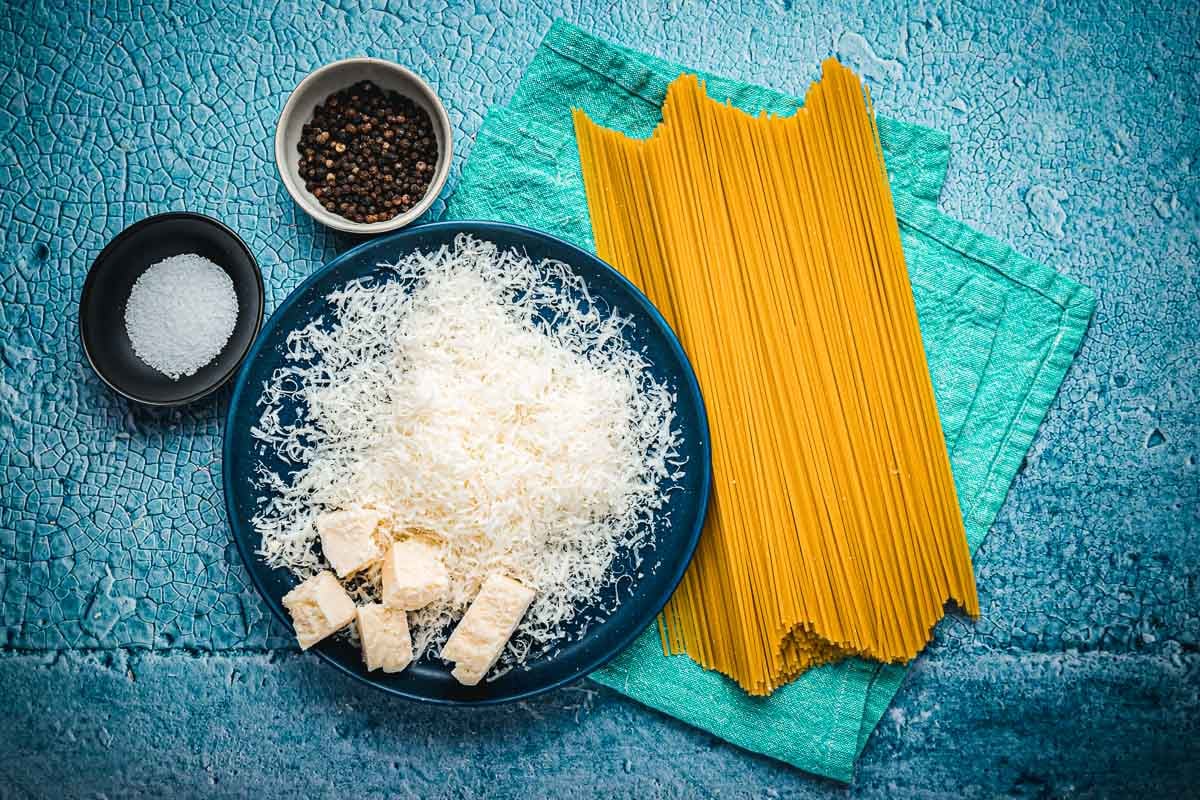
What is in Cacio e Pepe?
You only need a few ingredients to make this cacio e pepe recipe, and if you’re like me, you already have them in your pantry.
- Pecorino Romano cheese: This aged sheep’s milk cheese has a pale hue, black rind, and a dry, crumbly texture that makes it good for grating. These days, pecorino romano is available at most well-stocked supermarkets. You’ll need about 2 1/2 cups finely grated Pecorino Romano for this recipe. Avoid the temptation of buying pre-shredded cheese. It’s too thick and won’t melt quickly enough to create the creamy sauce you’re after. I recommend using a microplane and grating it yourself so it’s light and fluffy.
- Black pepper: To get the most flavor, start with whole black peppercorns. Grind them yourself, either with a mortar and pestle or a spice grinder.
- Pasta: You’ll need a pound of boxed or packaged pasta for this recipe, enough to serve 4 to 6. Spaghetti is the traditional pasta for cacio e pepe, but even Roman establishments now use popular shapes such as rigatoni, bucatini, and thick, square-cut noodles called tonnarelli. Use a good quality brand that cooks evenly and retains its al dente bite.
- Pasta water: The salted water in which you boil your pasta is a key ingredient in this recipe. The boiling hot, starchy water helps to melt the pecorino cheese, forming a creamy, emulsified sauce.
How to Make Cacio e Pepe
Technique is everything with cacio e pepe. Making a creamy sauce that coats the noodles takes a bit of elbow grease and vigorous stirring, but once you’ve done it a couple of times it becomes easy.
- Put a pot of water on to boil. Fill the pot with just enough water to submerge the pasta. Use a little less water than you normally would so the water will be extra starchy as the pasta cooks. This will help in making a creamy sauce. When the water comes to a boil, add salt. Adding salt to pasta water helps to flavor the pasta. But remember that pecorino cheese is also very salty, so go easy when you salt the water. Boil the pasta, whether spaghetti or another shape, according to the package instructions, until al dente. It should be cooked through but firm to the bite.
- Grate the pecorino cheese. While the pasta boils, use a microplane or the small ‘star’ holes of a box grater to finely grate 4 ounces Pecorino Romano cheese. You’ll need about 3 very loosely filled cups. I use a microplane, as it produces a light, fluffy grated cheese that melts easily in the hot pasta water.
- Toast and grind the pepper. Place 1 tablespoon whole peppercorns in a small non-stick skillet and set it on medium-high heat. Toast the peppercorns, shaking the pan often, for 2 to 3 minutes, just until they release their fragrance. Let the peppercorns cool slightly, then pour them into a spice grinder or a mortar. Grind or pound the peppercorns until coarsely ground. The coarsely ground pepper adds both flavor and texture to cacio e pepe.
- Drain the pasta. Set a colander in the sink, with a heat-proof 2-cup measuring cup nearby. When the pasta is al dente, drain it in the colander set over a bowl. Reserve about 1 1/2 cups of the boiling water in the measuring cup. Return the pasta to the pot and pour in about 1/3 cup of the water. Return the pasta to the stove but don’t turn on the heat.
- Dress and serve the pasta. Sprinkle 2 teaspoons of pepper and a handful of pecorino into the pot followed by another splash of hot pasta water and immediately begin stirring as vigorously as you can to mix the cheese with the noodles and water. Add another splash of water and another handful of cheese and stir, stir, stir to create a creamy sauce. Elbow grease is the key here to prevent the cheese from clumping. Add one more, small handful of cheese—reserve a little for garnish—and a final splash of hot water. Stir until everything is nicely combined and the noodles are well coated. Transfer the pasta to bowls, garnish each serving with a sprinkle of pepper and pecorino cheese and serve immediately, while still hot.
Tips and Tricks
Cooks of my mother’s generation didn’t worry so much about creating the ‘perfect’ creamy sauce for cacio e pepe. They drained the noodles, added cheese and pepper, tossed to combine everything, and served.
It’s only in recent years that chefs and cooks have become fixated on obtaining an emulsified sauce for cacio e pepe. Here are some tips that will help you achieve cacio e pepe success every time.
- Grate the pecorino as finely as possible. A microplane is the best tool for this job. The grated cheese should be light and airy, not densely packed.
- Use more pepper than you think you should. Most of us use pepper in small quantities when we cook, almost as an afterthought. But pepper is central to cacio e pepe so it needs to shine. Use at least 2 teaspoons and toast before grinding to bring out the pepper’s spicy and fruity notes. Pounding the peppercorns in a mortar will give you a mix of coarsely and finely ground pepper, an ideal combination in my opinion. Whatever you do, don’t use ground pepper from a shaker or canister, as it won’t be nearly as fragrant or potent.
- Don’t dawdle. Cacio e pepe must be eaten hot. No matter how creamy you manage to get your sauce, it will stiffen as it cools. So: Mix, serve, enjoy!
- Find a mixing method that works for you. My preferred method to mix cheese, pasta water, and noodles together in the pasta pot and stir as if my life depends on it. But some cooks prefer to make a paste of cheese and pasta water and then mix everything together in a large bowl. Here’s how to do it: Combine 2/3 of the grated pecorino with the pepper and enough hot pasta water to create a paste. Whisk to work out any lumps, adding more water to help melt and dissolve the cheese. Using a pasta server or tongs, transfer the noodles from the pot straight to the bowl and stir vigorously to coat the noodles. Add more pasta water from the pot as needed to make a creamy sauce. While I have tried this method, I’ve found it to be extra messy, as bits of cheese and drops of sauce tend to fly out of the bowl. Give both methods a try and see which works best for you.

What to Serve with Cacio e Pepe
Cacio e pepe may be simple, but it’s rich. If you’re serving it as the main course, you can round it out with a salad, simply dressed with good olive oil and wine vinegar. Or for a twist on the classic, serve with scampi-style shrimp, as with my Shrimp Cacio e Pepe recipe.
I also like to serve it with broccoli, dressed with a squeeze of lemon juice, flaky salt, and my best olive oil. Cacio e pepe also makes a good primo piatto (first course), served in smaller portions. It goes especially well with vegetarian mains, such as stuffed peppers or zucchini. To drink, try a white wine with good acidity, such as Verdicchio or Vermentino. Or, if you prefer red, something on the lighter side, like Pinot Nero.
Leftovers
Leftover cacio e pepe makes an excellent spaghetti frittata: Mix the leftover pasta with beaten eggs and cook the mixture in an oiled cast iron skillet until browned on the bottom; then pass it under the broiler for a couple of minutes to finish cooking and brown the top.
More Pastabilities!
Browse all Mediterranean recipes.
Visit Our Shop.
Try our Nocellara-Italian Extra Virgin Olive Oil!
This EVOO is produced from hand-picked, cold-extracted Nocellara olives. High in polyphenols with aromas of fresh tomatoes and vegetables with a mildly bitter and spicy finish.

Cacio e Pepe
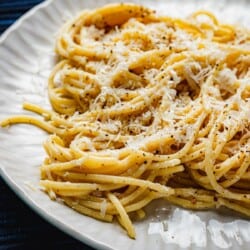
Ingredients
- 2 teaspoons salt
- 1 pound spaghetti, tonnarelli or bucatini pasta
- 4 ounces Pecorino Romano cheese, finely grated
- 1 tablespoon whole peppercorns
Instructions
- Salt the water: Fill a large pot with water, and set it over high heat. Bring it to a boil and add two teaspoons of salt.
- Boil the pasta: Add the pasta to the boiling water, reduce heat to medium high and cook according to package instructions until the pasta al dente.
- Grate the cheese: While the pasta is cooking, grate the cheese with a microplane or on the small star holes of a box grater. You should have about 3 cups of very fluffy cheese.
- Toast and grind the peppercorns: In a small skillet set over medium-high heat, add the peppercorns. Toast the peppercorns, stirring occasionally or just until they release their aroma. Cool slightly, then transfer them to a mortar or a spice grinder. Pound or grind the peppercorns to a mostly coarse grind with some finer specks but no large pieces.
- Drain and reserve pasta water: When the pasta is done, set a colander over a bowl, and drain the pasta. You want to reserve 1 1/2 cups of the boiling pasta water in a heat-proof measuring cup or bowl.
- Make the sauce: Do this part quickly! Return the pasta to the cooking pot and add 1/3 cup reserved pasta water. Set the pot on the burner but don’t turn the burner on. Sprinkle about 1/3 of the cheese, 2 teaspoons pepper, and a splash of the reserved pasta water. Use tongs or a pasta spork to stir vigorously to combine the ingredients. Add another splash of reserved pasta water and another 1/3 of the cheese and continue to stir to coat the noodles evenly. The sauce should look smooth and creamy. Add more cooking water, a splash at a time (if necessary) to loosen the sauce. You may not use all of the pasta water.
- Serve: Transfer the pasta to individual bowls. Top each serving with a spoonful of reserved pecorino and a pinch of pepper and serve.
Video
Notes
- Visit our shop to browse quality Mediterranean ingredients including olive oils, honey, jams and spices.


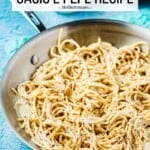

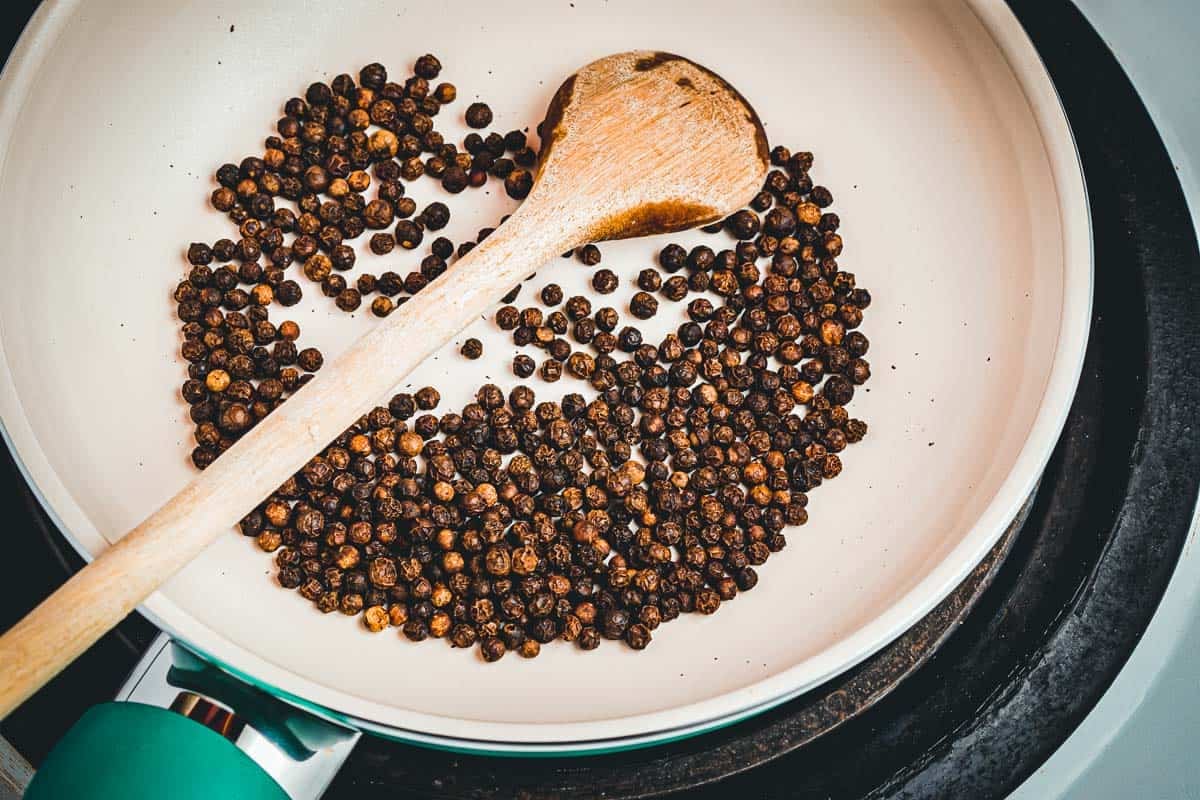
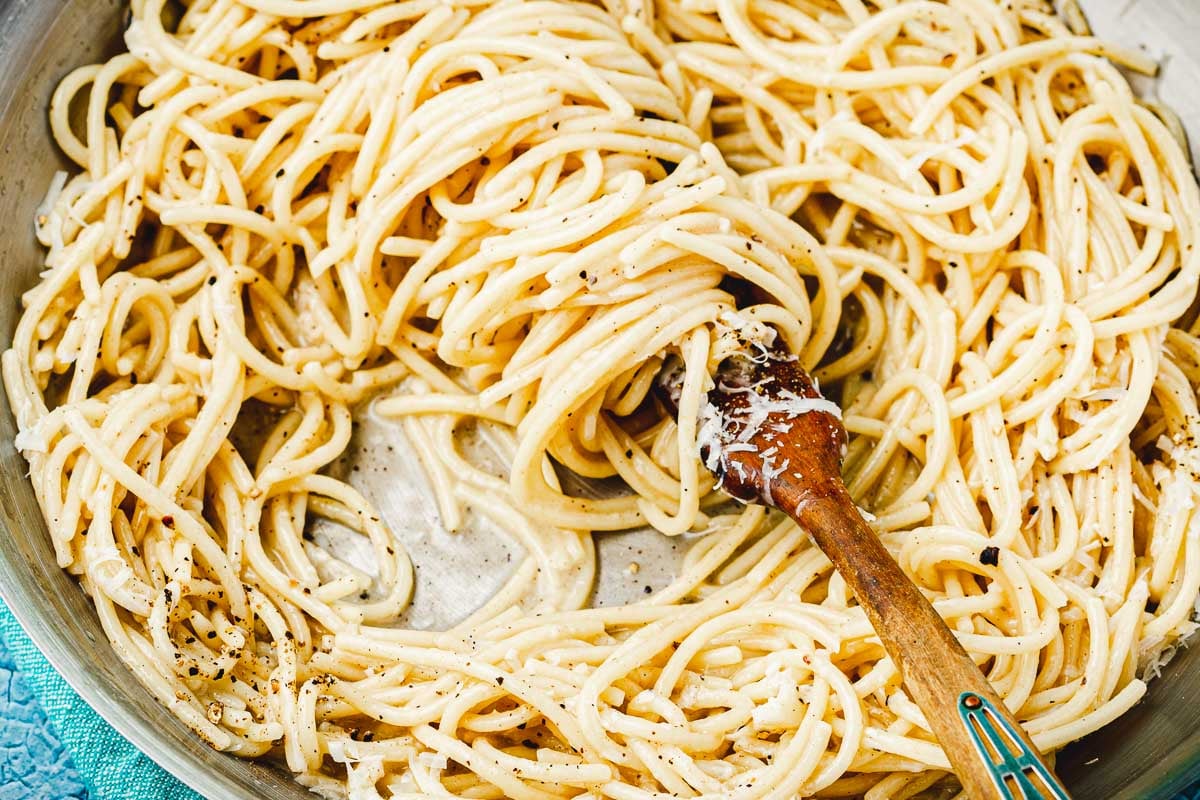
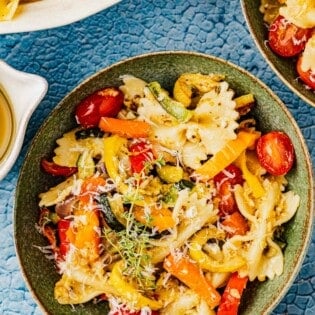
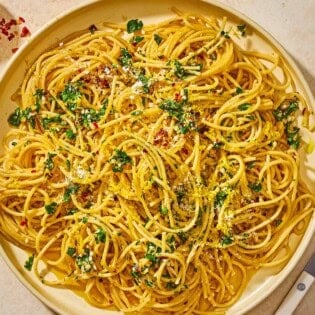


Side note if you have issues getting the cheese to blend correctly…blend it in a blender with the pasta water and it turns out perfect then throw on pasta
Thanks for the tip, Amanda!
Easy and delicious!
Great recipe. Easy to make and turned out perfectly. Delicious!
Loved it! Simple and delicious! Will make again and again
Ack – ended up way too peppery! I’m gonna have to try again another night.
Excellente
Just made this recipe and used fresh pasta. Followed the directions closely and WOW! Heating the peppercorns really changed the flavor for the better!! Highly recommend
Thanks so much, Richard!
Really nice thanks, I made a stock tho – toasted cracked peppercorn and bayleaf. Mixed half and half with pasta water, came out spicy, silky and good!
I made this for dinner tonight and it was a hit!! This is so delicious and super easy to make… Will make again and again.
Yay! Thanks, Maria!
This was delish! Are the nutritional facts per serving? Do you know how big each serving is? Thanks!
Hi, Kerrianne. Yes, the nutritional facts are per serving. This particular recipe can be divided by 6 to get the approximate “serving size”. The nutrition info here is our best effort and we use a program that calculates that for us based on the ingredient list. The exact serving size measurement (by grams, cups, etc) is another layer that’s harder for us to precisely calculate at the moment, but we’re working on it!
Delish!
This changed my life, girlfriend suggested it and she got the same, was so creamy, I didn’t believe when she said how was made, was so busy eating mine and rest of hers I forgot to say had run in pantyhose lol. Amazing dish
Thanks so much ~ really glad to hear it was a hit!
Yummy
This was awesome!!!!! We are going to try the leftovers with eggs tomorrow.
Belated thanks, April!
dd sume anchovy and my Uncle Aldo might rise from the grave to eat it!